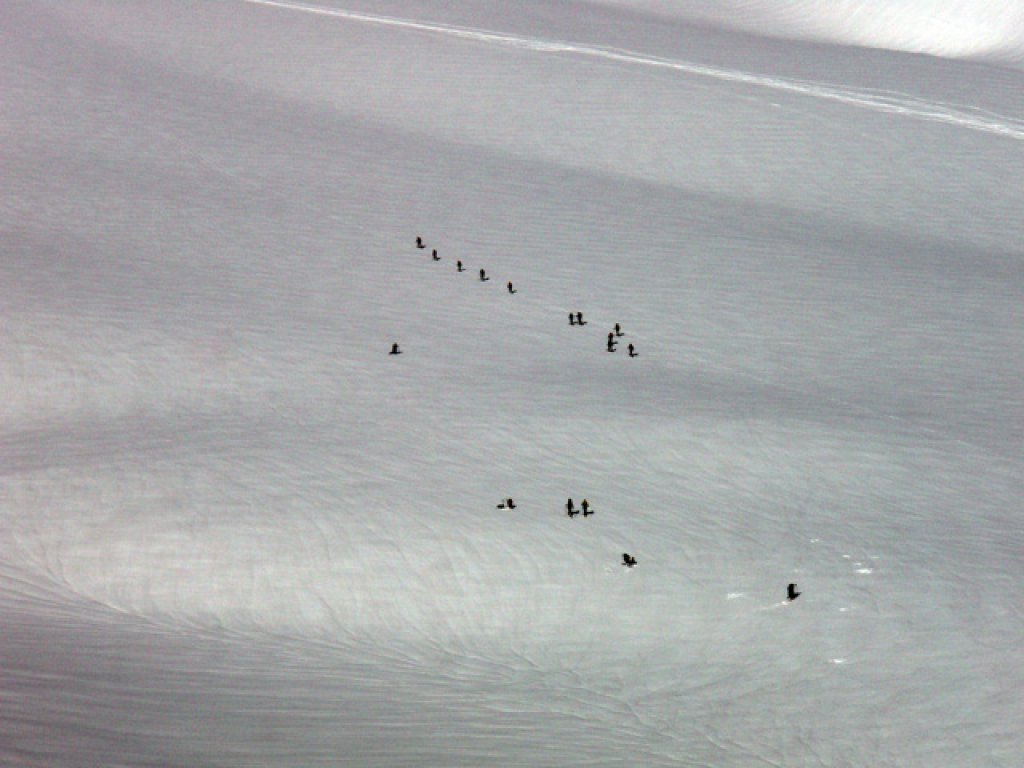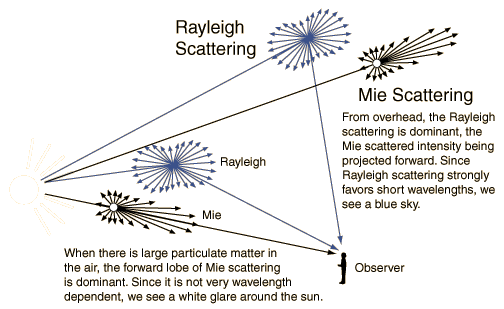Wer gestern, so wie der WetterBlog, in der Abenddämmerung auf alpenländischen Autobahnen unterwegs war, wird vielleicht die grenzwertig kitschige Lichtstimmung bewundert haben: Tiefhängender Vollmond vor zart pastellfarbenem Himmel, daneben glühende Berge. Angesichts solcher Naturschauspiele kann man innehalten, sich über das Hochdruckwetter in leichter Westströmung und die angenehm vorhersagbaren Firnverhältnisse freuen. Oder man überlegt sich, dass Luft doch eigentlich durchsichtig ist. Warum ist also der Himmel meistens blau, manchmal rot und in diesem Fall lilablassblau? Die Sonne gibt bekanntlich elektromagnetische Strahlung in allen möglichen Wellenlängen ab. Wir interessieren uns für den sichtbaren Teil des Spektrums, also Wellenlängen von circa 400 (lila/blau) bis 750 (rot) Nanometer.
Wenn das Sonnenlicht auf die Moleküle und sonstigen Teilchen in der Atmosphäre trifft, wird es daran gestreut. Sind die streuenden Teilchen deutlich kleiner als die Wellenlänge, spricht man von Rayleigh-Streuung. Die Streuung ist hier umgekehrt proportional zur vierten Potenz der Wellenlänge. Das heißt: kürzere (blaue) Wellenlängen werden stärker gestreut, und zwar nach vorne und hinten in einer Art Dipol-Muster. Überall in der Luft wird also blaues Licht an kleinen Molekülen herum gestreut, daher wirkt die Summe des Streulichts blau, zumindest wenn die Sonne hoch steht. Der Mond hat keine Atmosphäre, an der Licht gestreut werden könnte, der Himmel ist dort also immer schwarz und die Sonnenuntergänge sind in der Farbgebung eher gothic. Auf der Erde dagegen wird der Himmel bei Sonnenuntergang wunderbar farbig. Die Sonne steht tief über dem Horizont und das Licht muss einen weiteren Weg zurücklegen, bis es beim wartenden Beobachter ankommt. Auf diesem Weg passiert es allerhand Teilchen, die die Blauen Komponenten streuen, bis keine mehr übrig sind. Bei uns kommen nur lange, rötliche Wellenlängen an, die dann beispielsweise Berge rosa erscheinen lassen. Wenn wir mittags auf einem schneebedeckten Berg stehen, ist dieser üblicherweise weiß. Schon ein paar Bergketten weiter sind die Berge aber irgendwie gelblich. Ähnlich wie die Sonne strahlen die weißen Berge über das ganze sichtbare Spektrum. Auf dem Weg zu uns geht etwas blaues Licht verloren und das ankommende Licht hat daher einen Gelbstich. (Deswegen wird auch die Sonne gern als gelber Ball mit Haaren dargestellt. Die Haare symbolisieren das gleichmäßige Strahlen in alle Richtungen.) Wenn die Berge noch weiter weg sind, beginnt irgendwann das blaue Streulicht der Atmosphäre diesen Effekt zu überlagern und wir haben die verheißungsvollen blauen Berge am Horizont. Wird Licht an großen Teilchen gestreut, zum Beispiel an Wassertröpfchen, funktioniert das ganze etwas anders und heißt Mie-Streuung. Diese ist weitgehend wellenlängenunabhängig, das heißt alle Farben werden auf die gleiche Weise gestreut. Das Licht wird hier vor allem vorwärts gestreut, nicht in alle Richtungen wie bei der Rayleigh-Streuung. Mittags wirkt der Himmel in direkter Umgebung der Sonne weißlich und wird mit zunehmender Entfernung zu Sonne immer blauer. Wenn genug große Teilchen in der Atmosphäre sind, sehen wir Mie-Streuung als weißes Licht dort, wo wir direkt von den Sonnenstrahlen angeschienen werden. Licht, das uns nicht direkt trifft, kann auch auf diese Weise gestreut werden, wir sehen den Effekt aber nicht, da wir, außerhalb der Streurichtung sind.
Der Wetterblog wünscht weiterhin viel Spaß im noch verbleibenden Schnee (zum Wochenende wird es föhnig und warm mit einer Vorderseitenlage, die uns nächste Woche zum ersten mal 30° bescheren könnte) und einen schönen, nicht allzu langen Sommer mit vielen kitschigen Sonnenauf und -untergängen.






